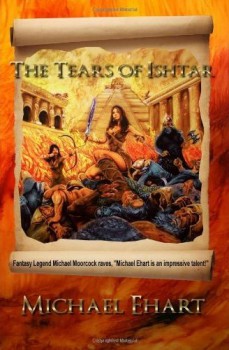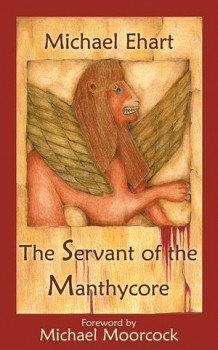A Look at The Tears of Ishtar
 The Tears of Ishtar
The Tears of Ishtar
Michael Ehart
Ancient Tomes Press (284 pp, $16.95, March 2010)
Reviewed by Bill Ward
Fans of Michael Ehart’s 2007 release The Servant of the Manthycore (Double-Edged Publishing) will find a lot of familiar ground in The Tears of Ishtar – in fact the later book contains all of the stories collected in the former, some of which have been enlarged or altered, alongside new material. While I will admit to feeling a slight twinge of disappointment upon discovering that I had already read most of the stories in this book (and, when one factors in those stories appearing in other anthologies such as Rogue Blades Entertainment’s Rage of the Behemoth, I think I may have read nearly all of these tales at one time or another), that feeling quickly dissipated. These are, after all, good stories in the tradition of classic sword & sorcery, and this new collection-cum-fix-up-novel showcases Ehart’s Ninshi stories in a more complete and ultimately satisfying way than the previous book.
The Tears of Ishtar spans something like 3,000 years in the life of the cursed, nearly immortal warrior woman Ninshi, the Servant of the Manthycore. Beholden to this legendary, man-eating beast, Ninshi spends long centuries luring men into murderous ambush to satisfy the Manthycore’s appetite – and in exchange is rewarded with brief glimpses of her imprisoned lover, a man ensnared by the Manthycore’s magic and used as leverage against her. But these grim transactions do not comprise the main action of The Tears of Ishtar, as Ninshi finds herself confronting all manner of gods and spirits as she wanders the lands of the ancient Near East. Set against the backdrop of the rise and fall of empires, Ehart’s stories, which move relentlessly forward and often skip centuries of intervening time, capture the sweep and almost unimaginable chronological depth of a time and culture too-often merely abstracted as ‘Ancient Mesopotamia.’ It is that familiarity with the nuances of history, the inclusion of solid details of material culture and belief, and frequent biblical and historical allusions, which elevate the setting of The Tears of Ishtar in a memorable and compelling way.
 Ehart paints his bronze age world with a few apt brushstrokes, as befits his economical and somewhat terse style. These stories do read primarily as short fiction, even though some have been elongated and partially rewritten to better serve the overall narrative arc of Ninshi’s saga. Those changes are seen primarily in the second section of the book, which deals with Ninshi’s episodic quest to retrieve the seven lost tears of the goddess Ishtar in order to learn the secret that will free her and the man she loves from the spell of Manthycore. Joined in this quest by Miri, a girl who becomes like a daughter to her, Ninshi must confront all manner of strange beasts and legendary antagonists – becoming herself something of a legend in the process. From jealous goddesses to amazons from the Indus, ferocious behemoths and determined cultists, Ehart populates his world with a rich array of encounters, obstacles, and characters drawn from the history and legend of the time.
Ehart paints his bronze age world with a few apt brushstrokes, as befits his economical and somewhat terse style. These stories do read primarily as short fiction, even though some have been elongated and partially rewritten to better serve the overall narrative arc of Ninshi’s saga. Those changes are seen primarily in the second section of the book, which deals with Ninshi’s episodic quest to retrieve the seven lost tears of the goddess Ishtar in order to learn the secret that will free her and the man she loves from the spell of Manthycore. Joined in this quest by Miri, a girl who becomes like a daughter to her, Ninshi must confront all manner of strange beasts and legendary antagonists – becoming herself something of a legend in the process. From jealous goddesses to amazons from the Indus, ferocious behemoths and determined cultists, Ehart populates his world with a rich array of encounters, obstacles, and characters drawn from the history and legend of the time.
Ninshi herself could easily become a cliché, but Ehart takes great pains to ensure that her prowess, though incredible, is rooted in reality. She is also a damaged, almost numb persona until her relationship with Miri humanizes and grounds her in something other than her murderous curse – but Ehart wisely avoids becoming overly sentimental here. This somewhat businesslike approach to storytelling accords well with his subject matter and the personality of Ninshi herself, and will satisfy fans of old school adventure fantasy as well as those looking for something less bloated than the typical fat fantasy offerings.
__________
A slightly different version of this review appeared in Black Gate Magazine #15
BILL WARD is a genre writer, editor, and blogger wanted across the Outer Colonies for crimes against the written word. His fiction has appeared in numerous magazines and anthologies, as well as gaming supplements and websites. He is an Editor at Black Gate, and 423rd in line for the throne of Lost Lemuria. Read more at BILL’s blog, DEEP DOWN GENRE HOUND.
Thank you for the kind words!
Sure thing, I was happy to review it.